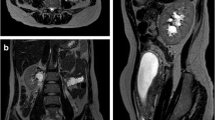Abstract
Objective
To evaluate the diagnostic value of the T1 bright appendix sign for the diagnosis of acute appendicitis in pregnant women.
Material and methods
This retrospective study included 125 pregnant women with suspected appendicitis who underwent magnetic resonance (MR) imaging. The T1 bright appendix sign was defined as a high intensity signal filling more than half length of the appendix on T1-weighted imaging. Sensitivity, specificity, positive predictive value (PPV) and negative predictive value (NPV) of the T1 bright appendix sign for normal appendix identification were calculated in all patients and in those with borderline-sized appendices (6-7 mm).
Results
The T1 bright appendix sign was seen in 51% of patients with normal appendices, but only in 4.5% of patients with acute appendicitis. The overall sensitivity, specificity, PPV, and NPV of the T1 bright appendix sign for normal appendix diagnosis were 44.9%, 95.5%, 97.6%, and 30.0%, respectively. All four patients with borderline sized appendix with appendicitis showed negative T1 bright appendix sign.
Conclusion
The T1 bright appendix sign is a specific finding for the diagnosis of a normal appendix in pregnant women with suspected acute appendicitis.
Key Points
• Magnetic resonance imaging is increasingly used in emergency settings.
• Acute appendicitis is the most common cause of acute abdomen.
• Magnetic resonance imaging is widely used in pregnant population.
• T1 bright appendix sign can be a specific sign representing normal appendix.




Similar content being viewed by others
Abbreviations
- MR:
-
Magnetic resonance
- PPV:
-
Positive predictive value
- NPV:
-
Negative predictive value
- US:
-
Ultrasonography
- CT:
-
Computed tomography
- WBC:
-
White blood cell
References
Rapp EJ, Naim F, Kadivar K, Davarpanah A, Cornfeld D (2013) Integrating MR imaging into the clinical workup of pregnant patients suspected of having appendicitis is associated with a lower negative laparotomy rate: single-institution study. Radiology 267:137–144
Andersen B, Nielsen TF (1999) Appendicitis in pregnancy: diagnosis, management and complications. Acta Obstet Gynecol Scand 78:758–762
Lahaye MJ, Lambregts DM, Mutsaers E et al (2015) Mandatory imaging cuts costs and reduces the rate of unnecessary surgeries in the diagnostic work-up of patients suspected of having appendicitis. Eur Radiol 25:1464–1470
Rosen MP, Ding A, Blake MA et al (2011) ACR Appropriateness Criteria(R) right lower quadrant pain--suspected appendicitis. J Am Coll Radiol 8:749–755
Masselli G, Derchi L, McHugo J et al (2013) Acute abdominal and pelvic pain in pregnancy: ESUR recommendations. Eur Radiol 23:3485–3500
Lee KS, Rofsky NM, Pedrosa I (2008) Localization of the appendix at MR imaging during pregnancy: utility of the cecal tilt angle. Radiology 249:134–141
Jang KM, Kim SH, Choi D, Lee SJ, Rhim H, Park MJ (2011) The value of 3D T1-weighted gradient-echo MR imaging for evaluation of the appendix during pregnancy: preliminary results. Acta Radiol 52:825–828
Beddy P, Keogan MT, Sala E, Griffin N (2010) Magnetic resonance imaging for the evaluation of acute abdominal pain in pregnancy. Semin Ultrasound CT MR 31:433–441
Singh AK, Desai H, Novelline RA (2009) Emergency MRI of acute pelvic pain: MR protocol with no oral contrast. Emerg Radiol 16:133–141
Singh A, Danrad R, Hahn PF, Blake MA, Mueller PR, Novelline RA (2007) MR imaging of the acute abdomen and pelvis: acute appendicitis and beyond. Radiographics 27:1419–1431
Goehde SC, Ajaj W, Lauenstein T, Debatin JF, Ladd ME (2004) Impact of diet on stool signal in dark lumen magnetic resonance colonography. J Magn Reson Imaging 20:272–278
Kundel HL, Polansky M (2003) Measurement of observer agreement. Radiology 228:303–308
Pedrosa I, Levine D, Eyvazzadeh AD, Siewert B, Ngo L, Rofsky NM (2006) MR imaging evaluation of acute appendicitis in pregnancy. Radiology 238:891–899
Pedrosa I, Lafornara M, Pandharipande PV, Goldsmith JD, Rofsky NM (2009) Pregnant patients suspected of having acute appendicitis: effect of MR imaging on negative laparotomy rate and appendiceal perforation rate. Radiology 250:749–757
Dewhurst C, Beddy P, Pedrosa I (2013) MRI evaluation of acute appendicitis in pregnancy. J Magn Reson Imaging 37:566–575
Pedrosa I, Zeikus EA, Levine D, Rofsky NM (2007) MR imaging of acute right lower quadrant pain in pregnant and nonpregnant patients. Radiographics 27:721–743, discussion 743-753
Kovanlikaya A, Rosenbaum D, Mazumdar M, Dunning A, Brill PW (2012) Visualization of the normal appendix with MR enterography in children. Pediatr Radiol 42:959–964
Petkovska I, Martin DR, Covington MF et al (2016) Accuracy of unenhanced MR imaging in the detection of acute appendicitis: single-institution clinical performance review. Radiology 279:451–460
Cobben L, Groot I, Kingma L, Coerkamp E, Puylaert J, Blickman J (2009) A simple MRI protocol in patients with clinically suspected appendicitis: results in 138 patients and effect on outcome of appendectomy. Eur Radiol 19:1175–1183
Author information
Authors and Affiliations
Corresponding author
Ethics declarations
Guarantor
The scientific guarantor of this publication is Yong Eun, Chung.
Conflict of interest
The authors of this manuscript declare no relationships with any companies, whose products or services may be related to the subject matter of the article.
Funding
This study has received funding by the Basic Science Research program through the National Research Foundation of Korea (NRF) funded by the Ministry of Education (NRF-2014R1A1A2057091)
Statistics and biometry
No complex statistical methods were necessary for this paper.
Ethical approval
Institutional Review Board approval was obtained.
Informed consent
Written informed consent was waived by the Institutional Review Board.
Methodology
-
retrospective
-
observational
-
performed at one institution
Rights and permissions
About this article
Cite this article
Shin, I., An, C., Lim, J.S. et al. T1 bright appendix sign to exclude acute appendicitis in pregnant women. Eur Radiol 27, 3310–3316 (2017). https://doi.org/10.1007/s00330-016-4727-2
Received:
Revised:
Accepted:
Published:
Issue Date:
DOI: https://doi.org/10.1007/s00330-016-4727-2




